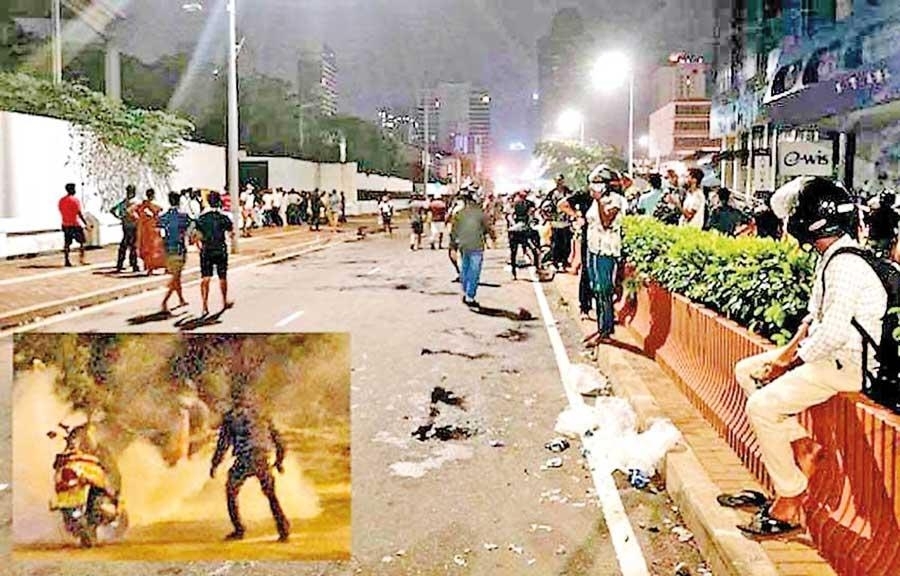Our home grown democracy begins now ! That's what we are at world's laughable place now !!

Goons, mainly Mahinda Rajapaksa loyalists armed with clubs and sticks unleashed thuggery and mayhem, went on a rampage at the unarmed and peaceful protesters at the Gotagogama at Galle Face and near Temple Trees on May 9.
The plan to extinguish the month long protest to oust the Rajapaksa family including President Gotabaya Rajapaksa from power by a sudden, violent attack (including demolishing the GotaGogama library and the St. John’s Ambulance service medical centre) backfired spectacularly. By evening, the protesters were not only back rebuilding the ravaged protest site; properties belonging to the Rajapaksa family, their cronies and close supporters were being attacked and torched all over the island.
The signal is strong and clear. The people’s revolution, hitherto peaceful, cannot be checked by violence. But why am I calling this the start of Sri Lanka’s home-grown democracy?
The democratic system of government inherited from Britain in 1948 has undergone many radical changes, mainly in 1972 (when the country became a Republic but also ceased to be a secular state) and 1978 (when the presidential system was introduced). All such changes contributed to the undermining of democracy, weakening law and order institutions and significantly reducing people’s rights. The law becomes a joke when the traffic police book you for crossing a white line on the highway, but critics of the government are kidnapped and disappeared, and trials (if they happen at all) get nowhere and eventually investigators and witnesses are charged for libel by the accused parties.
But it’s not just a cry from the graves that led to the spectacular ouster of Mahinda Rajapaksa. It is hunger and deprivation. It is sobering to think that many of those braved rain, hunger and possible reprisals, protesting with “GotaGoHome” and other placards since April 9 are the same people who celebrated in the streets with milk rice and firecrackers when the Mahinda-Gotabaya juggernaut ended the country’s seemingly endless civil war in 2009.
I remember a significant slogan floated by the Rajapaksa regime soon afterwards: “Dan kelehiguna salakamu” (let’s show our gratitude now). One can see where this super highway of gratitude finally led us – to the torching of properties belonging to the Rajapaksa family and their cronies.
Mahinda Rajapaksa’s presidency ended in 2015, against all expectations, because of the excessive greed of his regime at public expense. But the same voters (and many more) voted in his younger brother Gotabaya as president back in 2019, giving his government an unprecedented majority, simply because the lacklustre Yahapalanaya government was seen as detrimental to business interests.
On April 9, many of those voters began apologizing for their mistake, but the Rajapaksas’ hold on power still seemed unshakable. Gotabaya Rajapaksa is not the sole architect of the military defeat of the LTTE. But he took all the credit. Within months of becoming president, he displayed a shocking lack of political acumen and commonsense. But this was completely ignored. People even said his lack of political experience is a blessing.
Eventually, Gotabaya may get all the blame for the political destruction of the Rajapaksa dynasty. But Gotabaya as president is very much Mahinda Rajapaksa’s creation. MR, ‘the king’ did a huge amount of damage to the country’s psyche, moulding an entire generation into believing that force and violence is the best way, that with ‘pure’ indigenous values, based on fundamentalist Buddhism, Sri Lanka can develop without outside help. He ruined the country’s international image. With his egocentric brother, he began militarising civil society, a process which still continues. Just as bad, he watched with approval as his brother Basil Rajapaksa, a man not fit to be the manager of a rural bank, was appointed finance minister, destroying the economy and reducing millions into poverty. In short, Mahinda Rajapaksa reaped what he sowed.
